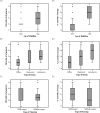Environmental factors influencing fungal growth on gypsum boards and their structural biodeterioration: A university campus case study
- PMID: 31374095
- PMCID: PMC6677307
- DOI: 10.1371/journal.pone.0220556
Environmental factors influencing fungal growth on gypsum boards and their structural biodeterioration: A university campus case study
Abstract
The new era in the design of modern healthy buildings necessitates multidisciplinary research efforts that link principles of engineering and material sciences with those of building biology, in order to better comprehend and apply underlying interactions among design criteria. As part of this effort, there have been an array of studies in relation to the effects of building characteristics on indoor microbiota and their propensity to cause health issues. Despite the abundance of scientific inquiries, limited studies have been dedicated to concomitantly link these effects to the deterioration of 'structural integrity' in the building materials. This study focuses on the observed biodeteriorative capabilities of indoor fungi upon the ubiquitous gypsum board material as a function of building age and room functionality within a university campus. We observed that the fungal growth significantly affected the physical (weight loss) and mechanical (tensile strength) properties of moisture-exposed gypsum board samples; in some cases, tensile strength and weight decreased by more than 80%. Such intertwined associations between the biodeterioration of building material properties due to viable indoor fungi, and as a function of building characteristics, would suggest a critical need towards multi-criteria design and optimization of next-generation healthy buildings. Next to structural integrity measures, with a better understanding of what factors and environmental conditions trigger fungal growth in built environment materials, we can also optimize the design of indoor living spaces, cleaning strategies, as well as emergency management measures during probable events such as flooding or water damage.
Conflict of interest statement
The authors have declared that no competing interests exist.
Figures






Similar articles
-
Indoor microbiota in severely moisture damaged homes and the impact of interventions.Microbiome. 2017 Oct 13;5(1):138. doi: 10.1186/s40168-017-0356-5. Microbiome. 2017. PMID: 29029638 Free PMC article.
-
Growth of indoor fungi on gypsum.J Appl Microbiol. 2017 Aug;123(2):429-435. doi: 10.1111/jam.13487. J Appl Microbiol. 2017. PMID: 28489278
-
Indoor air particles and bioaerosols before and after renovation of moisture-damaged buildings: the effect on biological activity and microbial flora.Environ Res. 2008 Jul;107(3):291-8. doi: 10.1016/j.envres.2008.02.008. Epub 2008 May 6. Environ Res. 2008. PMID: 18462714
-
Moisture parameters and fungal communities associated with gypsum drywall in buildings.Microbiome. 2015 Dec 8;3:71. doi: 10.1186/s40168-015-0137-y. Microbiome. 2015. PMID: 26642923 Free PMC article. Review.
-
Indoor mould development and dispersal.Med Mycol. 2007 Feb;45(1):1-9. doi: 10.1080/13693780600928495. Med Mycol. 2007. PMID: 17325938 Review.
Cited by
-
Damp Buildings: Associated Fungi and How to Find Them.J Fungi (Basel). 2024 Jan 27;10(2):108. doi: 10.3390/jof10020108. J Fungi (Basel). 2024. PMID: 38392780 Free PMC article. Review.
-
Chemical composition of material extractives influences microbial growth and dynamics on wetted wood materials.Sci Rep. 2020 Sep 2;10(1):14500. doi: 10.1038/s41598-020-71560-3. Sci Rep. 2020. PMID: 32879425 Free PMC article.
-
On the Response to Aging of OPEFB/Acrylic Composites: A Fungal Degradation Perspective.Polymers (Basel). 2023 Jan 30;15(3):704. doi: 10.3390/polym15030704. Polymers (Basel). 2023. PMID: 36772005 Free PMC article.
-
Fungal Contamination of Building Materials and the Aerosolization of Particles and Toxins in Indoor Air and Their Associated Risks to Health: A Review.Toxins (Basel). 2023 Feb 25;15(3):175. doi: 10.3390/toxins15030175. Toxins (Basel). 2023. PMID: 36977066 Free PMC article. Review.
-
A comparison of several media types and basic techniques used to assess outdoor airborne fungi in Melbourne, Australia.PLoS One. 2020 Dec 18;15(12):e0238901. doi: 10.1371/journal.pone.0238901. eCollection 2020. PLoS One. 2020. PMID: 33338037 Free PMC article.
References
-
- Flannigan B, Samson RA, Miller JD. Microorganisms in home and indoor work environments: Diversity, health impacts, investigation and control 2nd ed. Boca Raton, FL: CRC Press; 2011.
-
- Nielsen KF, Nielsen PA, Thrane U, Larsen TO, Gravesen S. Production of mycotoxins on artificially inoculated building materials. Int Biodeterior Biodegradation. 1998;42(1):9–16.
Publication types
MeSH terms
LinkOut - more resources
Full Text Sources
Medical
Research Materials

